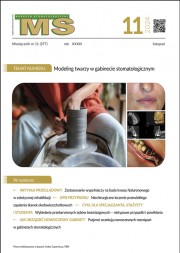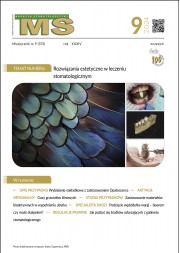Dostęp do tego artykułu jest płatny.
Zapraszamy do zakupu!
Cena: 5.40 PLN (z VAT)
Kup artykuł
Po dokonaniu zakupu artykuł w postaci pliku PDF prześlemy bezpośrednio pod twój adres e-mail.
Treatment with implants in the lateral segments of the maxilla
Marcin Tutak, Marta Kłonica, Tomasz Smektała, Marcin Jędrzejewski, Katarzyna Sporniak-Tutak
Marcin Tutak, Marta Kłonica, Tomasz Smektała, Marcin Jędrzejewski, Katarzyna Sporniak-Tutak
Streszczenie
Odcinek boczny szczęki to obszar o niedostatecznych parametrach dotyczących ilości i jakości tkanki kostnej. Ponadto w tej okolicy występuje zatoka szczękowa, która po utracie uzębienia powiększa swoją objętość kosztem wyrostka zębodołowego. Wiąże się to z dodatkowymi utrudnieniami w leczeniu implantologicznym w tym odcinku.
W artykule przestawiono istotne zagadnienia dotyczące anatomii zatoki szczękowej, które mogą mieć wpływ na przebieg zabiegów chirurgicznych i ewentualne powikłania. Szczegółowo opisano techniki podniesienia dna zatoki metodą zamkniętą i otwartą oraz ich skuteczność. Przedstawiono rodzaje materiałów stosowanych do augmentacji dna zatoki. Omówiono również alternatywne rozwiązania implantologiczne, takie jak podniesienie dna zatoki szczękowej bez użycia materiałów wypełniających oraz zastosowanie wszczepów jarzmowych.
Hasła indeksowe: zatoka szczękowa, wszczepy zębowe, augmentacja dna zatoki szczękowej
Summary
The lateral segment of the maxilla is an area with insufficient parameters regarding the quantity and quality of bony tissue. Furthermore, in the vicinity there is the eye orbit which, after the loss of teeth, enlarges in volume at the cost of the dental alveolus. This is associated with additional difficulties in treating with implants in this segment.
The article describes significant aspects regarding the anatomy of the maxillary sinus that may have an influence on the outcome of surgical procedures and on possible complications. In particular there is a description of the technique of lifting the floor of the sinus using closed and open techniques and their effectiveness. There is a presentation of the types of grafting material used for augmentation of the floor of the sinus. There is also a discussion of alternative solutions using implants, such as the lifting of the sinus floor without the use of grafting materials and with the use of zygomatic implants.
Key words: maxillary sinus, dental implants, sinus floor augmentati













